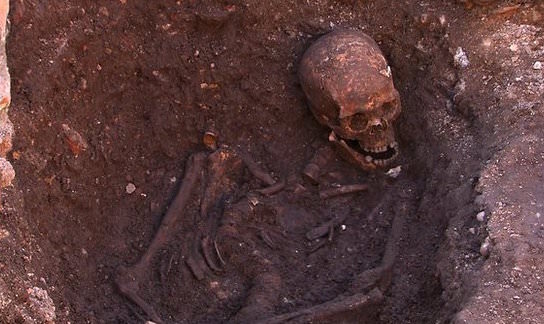King Richard III’s DNA questions bloodline of royal family, Richard III’s remains continue to give up secrets the English king would probably prefer be kept buried. Since discovering his remains under a parking lot in Leicester in 2012, scientists have determined he had a bad case of roundworms and died a brutal death.
[fwdevp preset_id=”8″ video_path=”yYY-usw9K_U”]Paternity tests on the DNA of a living male-line descendant of Richard III’s royal lineage have failed to find a match, which points to some royal person being born on the wrong side of the bed sheets, the researchers revealed.
The latest research into the DNA extracted from the 15th century skeleton shows unequivocally that the remains belong to Richard III, who died in the battle of Bosworth in 1485, said Turi King of Leicester University, the lead author of the study published in Nature Communications.
“Even with our highly conservative analysis, the evidence is overwhelming that these are indeed the remains of King Richard III, thereby closing an over 500-year-old missing person’s case,” Dr King said.
Mitochondrial DNA extracted from the skeleton, which is passed on exclusively through the maternal line, matches precisely with two female-line descendants alive today, who are both 14th cousins twice removed from Richard III, Dr King said.
These findings, combined with other circumstantial evidence, give a probability of the skeleton belonging to Richard as 99.9994 per cent, the scientists said.
However, DNA analysis of the Y chromosome of Richard did not match a living descendant of Henry, fifth Duke of Beaufort, who was supposed to be related to Richard through the male line, Dr King said.
“Doing the Y-chromosome research I found there wasn’t a link between Richard III and the male-line relatives who are alive today. So clearly although the genealogy says they are male-line related, the DNA is telling us that there has been a non-paternity or break in that Y-chromosome chain between the 5th Duke of Beaufort, who is their common male-line ancestor, and Richard III, which is 19 generations between them,” she said.
This suggests that the male-line lineage descended from Richard’s great-great grandfather, Edward III, was broken at some point in history, calling into question various claims to the throne – including that of the Tudors, said Kevin Shurer, professor of local history at Leicester University.
“The fact that we have a break means just that: we have a break. It doesn’t mean the skeleton isn’t Richard because what we have is the very strong evidence triangulated with two living-day relatives with the mitochondrial DNA,” Professor Shurer said.
“So that in itself is very strong compelling evidence that the skeleton is Richard III. The break however does raise other questions, more of a historical nature than is this skeleton Richard,” he said.
It is not unusual for find that the male line is broken in DNA cases looking back over several generations. Scientists estimate that the rate of non-paternity is about two per cent. However the discovery could have wider implications.
“Depending on which link in the chain is broken, and of course there is the possibility that there could be more than one break, this asks questions about the Plantagenets and of course the claims to the throne of both the Houses of York and Lancaster,” Professor Shurer said.
“The critical [links in the chain] are between Edward III and his son John of Gaunt. If the break occurs here then this asks questions about the legitimacy of John’s son Henry IV and his subsequent heirs, Henry V and Henry VI,” he said.
“In addition, since the Tudor dynasty was also descended from John of Gaunt there is an indirect influence over the Tudors’ claim to the throne,” he added.
“Likewise if the break is in the part of the chain from Edward III to Richard III this would also ask questions about the legitimacy of the claims of both Richard and of course his brother Edward – but we have absolutely no proof of that,” he emphasised.
“There are 19 links in this chain, five of them could affect royal descent. So statistically the chances are it actually has had no effect at all. But it would be worthwhile investigating further to try and understand more fully where that breakage occurred,” Professor Shurer said.
Agencies/Canadajournal
 Canada Journal – News of the World Articles and videos to bring you the biggest Canadian news stories from across the country every day
Canada Journal – News of the World Articles and videos to bring you the biggest Canadian news stories from across the country every day



